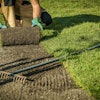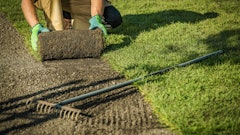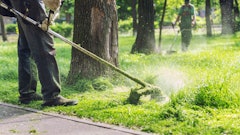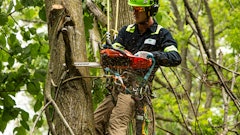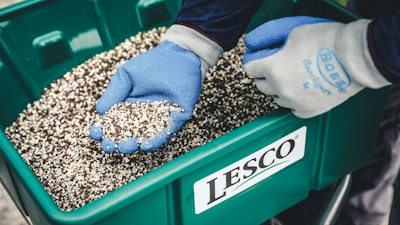
The final frost of the season will be here before we know it, so it’s time once again to create your lawn care fertilizer program for the year. Without question, the way you plan your lawn care program will depend on what region you’re in and what equipment you use. There are, however, some common trends across the country when it comes to planning your fertilizer program.
Green Industry Pros recently spoke with Jeremy Bigler, landscape channel manager for Lebanon Turf, which produces fertilizers, grass seed and weed control products, and Brian Rowan, vice president, category management for SiteOne Landscape Supply, a national supplier of turf and landscape maintenance tools and products about fertilizer trends.
Weeds and Insects
No matter where you and your lawn care program are located, there are typically weeds and pests to curtail.
“The very basic building blocks are usually centered around controlling weeds and insects and matching that with the right fertility components for the region,” Bigler said.
In the spring, lawn care providers are applying pre-emergent herbicides to prevent grassy weeds, followed by post-emergent herbicides to control broadleaf weeds, he said.
Bigler went on to explain, “In early summer, insecticides are used to prevent damage from white grubs. During the fall when it is the optimal time for seeding, you will typically want to apply a good starter fertilizer to help the new turf establish quickly.”
Choosing the Right Fertilizer for Your Customers
Using fertilizers that are high in nutrients are the common-sense solution for a successful lawn program, Bigler said.
Starting with a soil test is a good way to determine the correct nutrient combo of nitrogen, phosphorous and potassium (NPK) to use on lawns in your region.
Bigler continued, “It starts with developing a good agronomic program for the year and then based on that finding the fertilizers that fit their plan. Fertilizers that contain high nutrient values and contain a high slow release content are recommended. They last longer, requiring less applications, and they are more economical when comparing the cost per acre.”
Fertilizers that result in a fast green-up have been popular with landscape contractors for years. But there are downsides, too.
“Those have been staple products for many, many years for customers of ours, for landscape professionals who are on the property every four to five weeks or every five to six weeks,” SiteOne’s Rowan said. “The downside to those products is a lot of the nitrogen, in particular, is lost immediately through electrification or leaching through the soil profile.”
Losing nutrients through runoff and other issues means landscape contractors have to return to those lawns early to reapply, which costs time and money.
Slow-Release and Coating Technology Advances
Improved technology has brought about an increase in the number of slow-release fertilizers that inhibit nitrogen absorption.
“Nitrification inhibitors have really come onto the scene and continue to make technology improvements that allow somebody to still have that lower price point and make it to the residential customers’ property more often,” Rowan said.
Slow-release fertilizers are becoming more environmentally friendly and make better use of nitrogen between visits, he said.
Rowan explained that fertilizer coatings that allow for a slow release of nutrients have been around for decades – and said advancements in the past decade have been a game changer for the landscape contracting industry.
“I think that where you're really seeing the advancement there is twofold. One is the quality of the coatings improving, so you can really dial in and know when a given particle is going to release,” he said. “The second aspect of that is we're getting really good at dialing in exactly how long it'll take for the product to release.”
SiteOne distributes slow-release fertilizers that can be customized to release when the customer wants, ranging from 45 to 180 days. “We can dial in a 45-day product. We can dial in a product that releases with a very steady release turnover,” said Rowan. “We can do 60 days, or 90, or 120, or 180. The consistency of the release curve over that span wasn't nearly as good 10 years ago as it is today.”
Signs Your Fertilizer Program Isn’t Working
Now that we’ve learned some ways to improve a fertilizer program, what are some signs fertilizers aren’t working as they should? For one, Bigler said, you’ll hear from customers.
“Excessive numbers of call-backs because of weed breakthrough,” he said, means it’s time to review the fertilizers you’re using.
To Rowan, there are several markers to consider when deciding whether you’re using the right fertilizer on the correct lawns:
- Application Interval: If the turf isn’t being fed consistently between applications, it may be time to make a fertilizer shift, Rowan said. “Folks build their business around a certain number of applications in a year, and they try not to change that frequency more than they need to,” he said. “They're doing seven applications in the transition zone and that means they're going to be on the property, say every six to eight weeks during the season. They want their products to last, or to span, that time. They don't want to put down an application, and then four weeks later have the benefits go away, and the lawn, go from green to brown prior to their next visit. They really want the products to release and perform through the span of their intervals,” he explained.
- Non-responsive Turf: When was the last time you did a soil test on your customers’ lawns? If your fertilizer isn’t producing green, healthy lawns, it could be the soil pH level. “If the soil pH is wrong and there is an improper balance of micronutrients in the soil, that might cause the nitrogen to not release, or the phosphorus to not be available,” Rowan said. “When they're not seeing any turf response from a product that they normally would see a response from, or if they're not seeing a response on some property, but they're seeing the proper response on other properties in their portfolio, that would be a good time to do a soil test and understand why the product isn't performing as it should. In that case, they might not change products. They might need to add another product to get their existing fertility product to perform better.”
- Pay Attention to Local Research: Look up your local land-grant university, or ag-school to read their latest research, Rowan said. “Almost every state has a very qualified, land grant university, so pay attention to the research being done there,” he said. “That can help them with everything from insect infestation, timing of insect infestation, to new varieties of turf and how fertilizers are responding and weather and stuff like that. That's always a great source. I use that myself both for my job, and personally.”
- New Technology: Rowan suggests staying abreast of new technologies and new products that could improve your bottom line. “I think we went through a real lull in technology advances through the ‘90s and early 2000s, but over the last seven or eight years, there have been tremendous advancements in technologies,” he said. “In that case, it isn't about their existing product not performing. It's about finding products that may be either more efficacious or overall more profitable. Frankly, in many cases, we're going to be more environmentally friendly, and that's becoming a more important consideration with residential lawn care applications.”
- Work with a Knowledgeable Supplier: A good distributor will keep you up to date on trends and the best products for your region, he said. “Our job is to train our associates with the absolute most current information,” Rowan said. “They're the folks that are going to know the most about new technology. They're going to know the most about a new regulation and how those regulations impact the landscaper's business. So, make sure you have a good relationship with a very strong, good agronomic leader as your distributor.”




